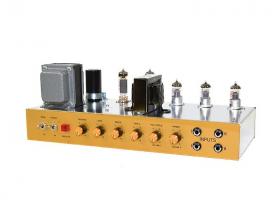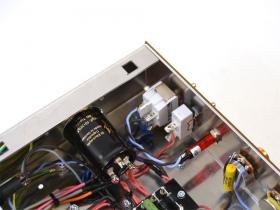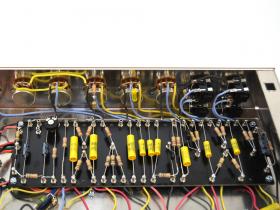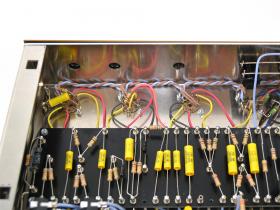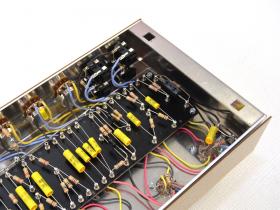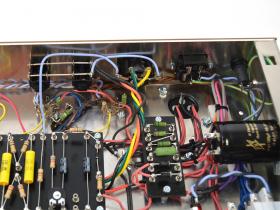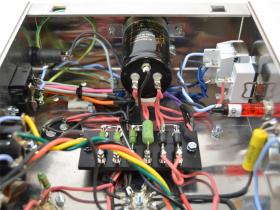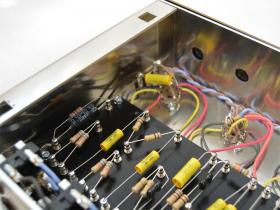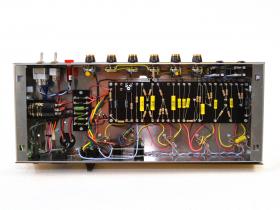
TT PX18
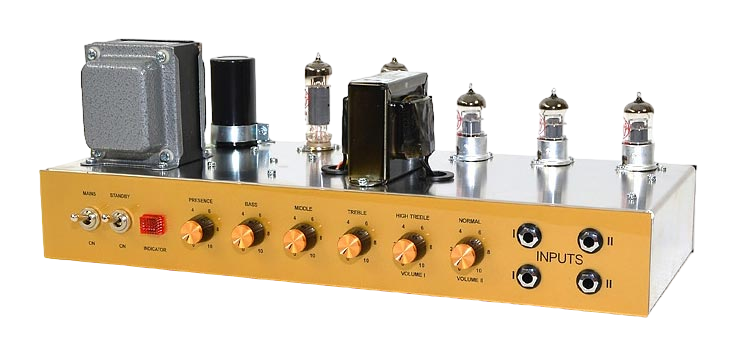
TT PX18
"Lead Model 1959. Four Inputs, separate volume controls for high treble input (channel 1) and normal inputs (channel 2). Presence, Bass, Middle and Treble tone controlscommon to both channels. ON/OFF switch and Stanby switch."
As simple as that the 1959 gets described in a Marshall brochure from the mid 60s and similarly simple is the entire circuit and layout of this amplifier. Still, without this amp, rock music in its present form would be hard to imagine: loud and raw. And for those who feel this amp is too loud, we have a very nice alternative available: the Tube-Town PX18 with tamed 18 watts, but the full Plexi sound.
The circuit of the 1959 Plexi was almost completely transferred into the PX18 and only adapted to EL84 power tubes. The changes and adjustments are, as you can see in a comparison of both circuits, very small and limited to a few components, as well as power transformer and output transformer. Furthermore, unlike its 18 Watt and SpitF. companions, the PX18 uses diode rectification instead of a tube rectifier. Because of this the anode voltage is a good deal higher compared to the classic 18 Watt based amps.
Another detail of the PX18: the bias is not generated by a cathode resistor on the power tubes but by its own bias supply, which is also adjustable and is commonly known as "adjustable fixed bias". The advantage of this type of bias generation is you can set the bias of the power tubes quite individually. The disadvantage compared to cathode bias is you'll have to check the bias after every power tube change in any case and may need to adjust.
Also there is a voltage divider implemented with the resistors R31 and R32, which is necessary to adjust the signal level for the EL84. However, if you want to try something rough, you are welcome to try the amp without the additional voltage divider.
About the sound
The great attraction of the 1959 Plexi PX18 are the two separate channels which are usually connected with a short patch cable and get used together. Since both channels are tuned very differently, especially at the treble frequencies, mixing both channels together produces a very complex sound, which can be further adjusted via the tone stack and the very effective presence control. And all this at tamed 18 watts, you can max out the PX18 completely and the neighbors do not need to move out quickly.
Bias Settings
As already mentioned above, the bias of this amplifier is set via the trimmer Tr50 and the current flowing through BOTH power tubes gets measured over the resistor R30. Voltage measurement in DC! The trimmer should be adjusted until the voltage measured across R30 is approximately 60 mV (which equals 60 mA for a 1 Ohm resistor).
Files
Schematic as PDF (2 Pages, DIN A4)
Layout as PDF (1 Page, DIN A3)
The kit is available together with other accessories at the TT-Shop
Warning!
Care is necessary during construction! Even though this is a low-watt amp, the voltages used are potentially fatal. This amp is NOT a beginner's project!
A successful build requires that you can read (and understand!) a schematic diagram, you know how to use various measuring devices, and you have some experience working with voltages over 60V.
Modification
With this mod the rectifier type can be switched between tube and diode rectification, which gives the possibility to operate the amplifier either with diode rectification or a tube rectifier. For diode rectification, the voltages are as listed in the wiring diagram, with tube rectification the voltages are slightly lower. The difference in sound is not very big, the effect lies primarily in the feeling and response while playing, furthermore the bass response with tube rectification seems to be a bit "softer".
Schematic as PDF ( 1 Seite, DIN A4 )
This modification is NOT part of the PX18 kit.

